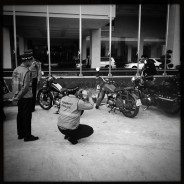
Uso de cookies
Este sitio web utiliza cookies para que usted tenga la mejor experiencia de usuario.
Si continúa navegando está dando su consentimiento para la aceptación de las mencionadas cookies y la aceptación de nuestra política de cookies.


20 April, 2016
As we went through Burma, the welcome in every stop, hotel or restaurant had a smile o curious, but reserved, eyes but with gentle gestures.
I mentioned in the previous post that travelling with the group allowed me a greater margin of movement because not everyone was moving at the same speed. In the touristic areas it allowed us go at our own pace. In my case, I wanted to give myself the perception of being free, but the tour guide told me that we were not as free as we thought. The government know the routes we take and there are many informants along the way.
When I heard this I thought I was something like Jim Carrey in The Truman Show in which everyone knows who you are and where you are at but you are not aware of it.
From that moment onwards I started to pay close attention to my surroundings, somewhat playfully trying to see if I could identify informants. All of the sudden, I imagined I was seeing actors all around me playing the role of the locals and their activities across the towns we passed through.
We had that conversation as we waited for the rest of the group on the outskirts of the new Burmese capital, Naypyidaw, because the road to the hotel had to be made with a police escort as if we were state dignitaries.
And so, as we went through this new metropolis, built in the middle of rice and sugarcane fields some 300km from the old capital, Rangoon, I felt as if I was in a ghost town. Left and right, we saw immense hotels, buildings that appeared to be shopping malls, roundabouts with massive concrete flowers and, instead of driving in line, we drove side to side (as if shoulder to shoulder) occupying all 8 lanes of huge avenues that stretched far ahead where the largest passenger plane built could land.
The only thing we crossed on the road to the hotel was a pair of police patrol cars that looked like it was stopping traffic. But the most bizarre thing was that there were no cars, or people. It was like entering a city where aliens had abducted the inhabitants and their vehicles. The only thing you see are broom men, in pairs, cleaning the untainted streets, or small worker groups piling up bricks with their bare hands. That was the contrast of manual labour in a modern city. The city is still under construction.
The control of where we were and what we did was very evident all the time we spent in Naypyidaw. The police took pictures of our motorcycles and escorted us anywhere we went, even inside pagodas.
Having reached this place, if you ask me if I would cross Burma in the same way I did, I would say yes. This is because it’s the only way to do it with your own vehicle. It was worth it, although I saw very little of the country. I have a feeling of frustration left, however, because I couldn’t experience, enjoy and photograph as I was doing in all previous countries. The daily routine of the tour is very tight and there is almost no time to spare in the day as we reach different destinations. Except in the more touristic areas like Bagan, Inle Lake or Mawlamyine where we stayed for two nights in each one.
The memories I want to keep from Burma are the brief lonely moments when I could stop in a small town in the middle of nowhere, with no guide or government minder around. Or the families that so kindly and lovingly welcomed me to their premises, smiling, passing me a plate of food with much kindness.